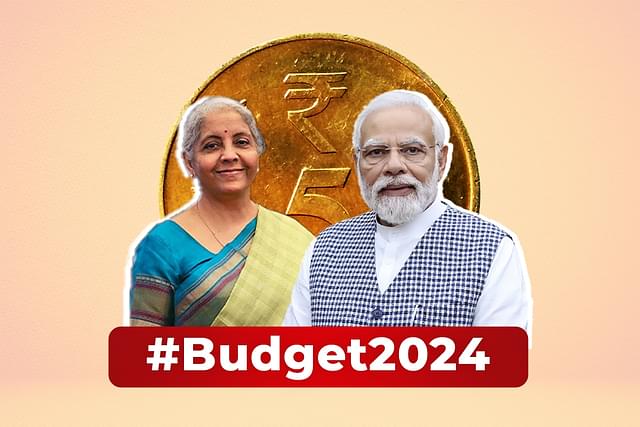Economy
A Budget That Shouts Political And Economic Confidence
R Jagannathan
Feb 01, 2024, 03:23 PM | Updated 03:22 PM IST
Save & read from anywhere!
Bookmark stories for easy access on any device or the Swarajya app.

What is one to make of an Interim Union Budget that actually lives up to its name? No freebies, no political gimmicks. No hint that a general election is due in less than two months.
The simple answer is that smart politics enables smart economics.
The real story of this Interim Budget is what preceded it: consistent and steady expansion of social safety nets to the vulnerable over a decade, good work on improving the economic environment for businesses, especially startups, smart fiscal and macroeconomic management in an uncertain global environment, and a sharp political build-up to match the emotive peak of the inauguration of the Ram Mandir in Ayodhya.
Net result: no need for freebies. This is in sharp contrast to the 2019 budget, which was interim only in name. If that budget reflected the Narendra Modi government’s concerns about the election outcome, 2024 is a signal of huge political confidence in continuity.
That said, there are some important signals coming from this budget.
First, apart from the continued infrastructure investment, which is 3.4 per cent of gross domestic product (GDP), there is a Rs 1 lakh crore fund to promote innovation and research and development with the help of ultra-long, interest-free loans.
It will take some time to fine-tune this fund to be effective, but it is supportive of the Modi vision of making India a developed nation by 2047. No country has ever become developed without large investments in R&D and innovation.
Second, the decision to keep borrowings in 2024-25 below the level of 2023-24 points to two things: one is the lower pressure on bond yields, which will enable the private sector to borrow more cheaply from banks and the markets in addition to raising equity from the stock markets.
The cost of capital will come down. Home borrowers will surely benefit later this year as rates soften. By borrowing less, the government is enabling the private sector to step up its investments — signs of which are already visible.
The other thing is the sharp reduction in the fiscal deficit to 5.1 per cent of GDP in 2024-25. This lower deficit signals that revenues may be better than expected. It also gives the government elbow room to spend if the economy flags for any reason.
Little wonder, Sitharaman went on to assert that “the next five years will be years of unprecedented development, and golden moments to realise the dream of developed India at 2047. The trinity of demography, democracy and diversity backed by ‘Sabka Prayas’ has the potential to fulfill the aspirations of every Indian.”
Third, the states are being incentivised to reform. A fund of Rs 75,000 crore is being used to get states to pursue reform in areas like power, where freebies are leading to huge losses for DISCOMS.
There is now indirect pressure to reform with the offer of subsidies for rooftop solar equipment. If the middle class and the poor generate their own power in significant numbers, the DISCOMS will have to rise to the challenge, since these consumers will feed surplus power into the grid.
Fourth, the middle class is being told to focus less on tax relief, and more on the benefits of better services. Under the new tax regime, anyone earning up to Rs 7 lakh per annum pays no taxes.
Refunds are now given faster, with average delays falling from 93 days to 10. And old tax demands (up to Rs 25,000 for the years till 2009-10 and Rs 10,000 for the next five years) are being written off. That’s relief of a different kind, but welcome nevertheless.
Overall, the message of the latest Nirmala Sitharaman budget is a return to empowerment politics over entitlements.
Modi is now taking India down a different path (which aligns with his original intentions), one driven by the adage of teaching a man to fish so that he can feed himself for a lifetime instead of being fed for free, with a diet of free fish. The voter is being told “stand up and improve your lot. We are behind you.”
A caveat and tailpiece: most of Modi’s big reforms and initiatives have not come from the budget. Demonetisation, digital payments, subsidy reforms using Jan Dhan, Aadhaar and Mobiles, the merger of the railway budget with the Union budget, the insolvency and bankruptcy code, corporate tax cuts, and the productivity-linked incentive scheme to boost manufacturing did not get announced in budgets. They came outside.
Modi reserves his biggest surprises for occasions outside budget day. So, an interim budget that is actually just an accounting exercise is no surprise.
Save & read from anywhere!
Bookmark stories for easy access on any device or the Swarajya app.
Jagannathan is Editorial Director, Swarajya. He tweets at @TheJaggi.
Support Swarajya's 50 Ground Reports Project & Sponsor A Story
Every general election Swarajya does a 50 ground reports project.
Aimed only at serious readers and those who appreciate the nuances of political undercurrents, the project provides a sense of India's electoral landscape. As you know, these reports are produced after considerable investment of travel, time and effort on the ground.
This time too we've kicked off the project in style and have covered over 30 constituencies already. If you're someone who appreciates such work and have enjoyed our coverage please consider sponsoring a ground report for just Rs 2999 to Rs 19,999 - it goes a long way in helping us produce more quality reportage.
You can also back this project by becoming a subscriber for as little as Rs 999 - so do click on this links and choose a plan that suits you and back us.
Click below to contribute.





